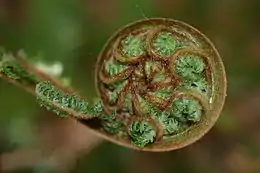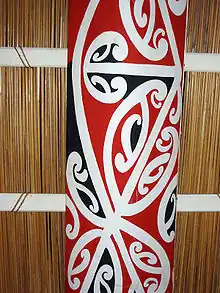


The koru (Māori for 'loop or coil')[1] is a spiral shape based on the appearance of a new unfurling silver fern frond.[2] It is an integral symbol in Māori art, carving and tattooing, where it symbolises new life, growth, strength and peace.[3] Its shape "conveys the idea of perpetual movement," while the inner coil "suggests returning to the point of origin".[3]
Use in traditional design
The koru is the integral motif of the symbolic and seemingly abstract kōwhaiwhai designs traditionally used to decorate wharenui (meeting houses). There are numerous semi-formal designs, representing different features of the natural world.[4]
More recent adaptations
The logo of Air New Zealand, the national carrier, incorporates a koru design — based on the Ngaru (Ngāti Kahungunu)[5] kōwhaiwhai pattern — as a symbol of New Zealand flora. The logo was introduced in 1973 to coincide with the arrival of the airline's first McDonnell Douglas DC-10 wide-body jet. Several other nationwide organisations also use a koru in their logos, among them the New Zealand Department of Conservation.
In 1983, Friedensreich Hundertwasser based his proposed design for a secondary New Zealand flag on the symbol. It also formed the basis for a notable series of artworks by Gordon Walters. Koru swirls are also reminiscent of the Tomoe symbol in Japan.[6]
The New Zealand national korfball team is nicknamed The Korus, although the plural for koru is koru.[7][8]
References
- ↑ Moorfield, John C. (2010). "Māori dictionary". Te Aka Māori-English, English-Māori Dictionary and Index. Te Whanake. Archived from the original on 22 July 2011. Retrieved 14 March 2010.
- ↑ Houlahan, Mike (27 December 2018). "The koru - arguably the best-known Maori symbol". Otago Daily Times. Retrieved 14 October 2022.
- 1 2 Royal, Te Ahukaramū Charles (March 4, 2009). "Māori creation traditions". Te Ara – the Encyclopedia of New Zealand. New Zealand Ministry for Culture and Heritage / Te Manatū Taonga. Retrieved 14 March 2010.
- ↑ Wison, Kemera "Whakairo" Maori Carving – Reading Kowhaiwhai", maori.org.nz. Retrieved 12 February 2014.
- ↑ "Maori Carving: Reading Kowhaiwhai". www.maori.org.nz. Retrieved 2018-02-07.
- ↑ "Koru Cross".
- ↑ "Māori Culture – New Zealand Trade Manual". www.newzealandtrademanual.com. Retrieved 7 March 2019.
- ↑ Most Māori words form their plural through a changed definite article rather than any change in the word itself. Thus, the plural of Te koru (the koru) is Ngā koru.